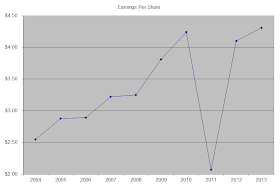The Clorox Company manufactures and markets consumer and professional products worldwide. It operates in four segments - Cleaning, Household, Lifestyle and International. This dividend champion has paid dividends since 1968 and has increased them for 36 years in a row.
The company’s latest dividend increase was announced in May 2013 when the Board of Directors approved a 10.90% increase in the quarterly annual dividend to 71 cents /share. The company’s peer group includes Procter & Gamble (PG), Colgate Palmolive (CL), and Kimberly Clark (KMB).
Over the past decade this dividend growth stock has delivered an annualized total return of 10.10% to its shareholders.
The company has managed to deliver a 6.40% average increase in annual EPS over the past decade. Clorox is expected to earn $4.46 per share in 2014 and $4.77 per share in 2015. In comparison, the company earned $4.31/share in 2013.
In addition, between 2004 and 2013, the number of shares decreased from 214 million to 132 million. The reason for the steep decline in shares is because in 2004 the company exchanged of its ownership interest in a subsidiary for approximately 61.4 million of its shares held by Henkel KGaA, which represented about 29% of CLX's outstanding common stock prior to the exchange. Since then, the company’s owners’ equity is negative, which throws off many novice dividend investors. There is a major difference between owners’ equity on the balance sheet and the value of the business to a private buyer. The reality is that while accounting is the language of business, it has certain limitations. The value of a high margin consumer staple business like Clorox is based mostly on earnings power, and not on the value of its assets as reported on the balance sheet.
Clorox has a portfolio of products with strong brand names, that are number one or two in their respective product lines, which helps in having pricing power. As a result, it should be able to pass on commodity price increases to customers. Future earnings growth could be driven by innovation, new product launches, cost containment initiatives, as well as international expansion.
As part of the company’s recently introduced 2020 Strategy, Clorox aims to continue delivering total stockholder returns in the top third of Clorox's peer group by driving economic profit (EP). In addition, the company's long-term financial goals include:
• Growing net sales 3-5 percent annually
• Expanding earnings before interest and income taxes (EBIT) margin 25-50 basis points annually
• Generating free cash flow of 10 percent to 12 percent of sales annually
The three pillars of the strategy include expansion in a geographic, category and channel direction, continued reinvestment in its brands as well as cost containment initiatives. A key driver of the strategy is to accelerate sales by growing existing brands, including expanding into adjacent categories, entering new sales channels and increasing penetration within existing countries. Increased exposure to emerging market economies could further drive increase in sales through 2020. The company also anticipates using its strong cash flow to pursue growth opportunities and increase shareholder returns. In addition to that the company will be targeting sales growth through product innovation, which helps its pricing power. Clorox will also target margin expansion and maximizing cash flow through implementation a continued robust cost-saving program and maintaining price increases the company has taken. The strong focus on cost, has provided the company with a relative cost advantage versus competition. In addition, Clorox continuously reinvests money in its brands, which helps it maintain its market position.
One of the risks behind Clorox is that it generates a large portion of revenues from the US – 78%. It is more exposed to the US economy than other global consumer staples companies, which could also be an opportunity as well. The other risk I see is that Wal-Mart (WMT) accounts for a quarter of sales for Clorox. Wal-Mart is notorious for trying to keep costs low, by squeezing vendors to sell at lower prices. This is bad for pricing power, and could impact profitability. This over reliance on Wal-Mart could be mitigated through continued international expansion.
The annual dividend payment has increased by 10.70% per year over the past decade, which is higher than the growth in EPS. This was accomplished through the expansion of the dividend payout ratio. Future growth will be limited by any growth in earnings per share.
An 11% growth in distributions translates into the dividend payment doubling every six and a half years on average. Since 1986, Clorox has been able to double dividends almost every seven years on average.
The dividend payout ratio increased from 42% in 2004 to almost 59% in 2013. A lower payout is always a plus, since it leaves room for consistent dividend growth minimizing the impact of short-term fluctuations in earnings.
The company’s Return on Assets has decreased slightly over the past decade. Rather than focus on absolute values for this indicator, I generally want to see at least a stable return over time.
Currently, the stock is fairly valued, as it trades at 19.50 times forward 2014 earnings and yields 3.30%. I am analyzing the company because I believe it is quality dividend growth stock, which will be a very good investment on dips below $86-$87.
Full Disclosure: Long CLX, PG, KMB, CL
Relevant Articles:
- Clorox Hikes Dividends, but is it a buy at current levels
- Nine Dividend Paying Stocks I Accumulated in the Past Month
- Procter & Gamble (PG) - A dividend stock to hold forever
- Why do I own so many individual dividend paying stocks
- Warren Buffett’s Dividend Stock Strategy




